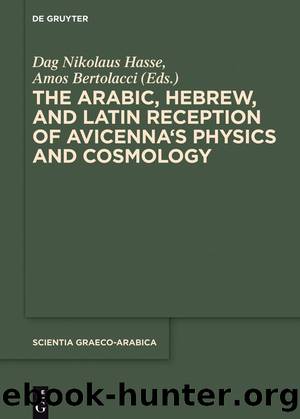The Arabic, Hebrew, and Latin Reception of Avicenna's Physics and Cosmology by Dag Nikolaus Hasse & Amos Bertolacci

Author:Dag Nikolaus Hasse & Amos Bertolacci [Hasse, Dag Nikolaus & Bertolacci, Amos]
Language: eng
Format: epub
ISBN: 9781614517740
Google: K4CbjgEACAAJ
Publisher: DeGruyter
Published: 2018-11-15T23:40:15.718521+00:00
This is the richest table of this article. Remember that the words in upright never appear in any other translator of the corpus and that those in italics appear only once outside Gundisalviâs translations. Together the terms pile up much evidence. The evidence for Avicennaâs Isagoge and Avicennaâs Physica is overwhelming. It has been a long-standing surmise that Dominicus Gundisalvi was the translator not only of Avicennaâs De anima, Philosophia prima and De convenientia et differentia scientiarum, but also of two other major parts of Avicennaâs summa al-Å ifÄʾ: the Isagoge and the Physica. The stylistic analysis of small words does not leave any doubt that this is indeed the case.
The evidence of the above table is also convincing for three other texts that are considerably shorter (as compared with the 24.673 words of Avicennaâs Isagoge and the 59.724 words of his Physica): Alexander of Aphrodisiasâ De intellectu (3.345 words), Alfarabiâs De intellectu (4.074 words) and the IḫwÄn al-á¹¢afÄʾâs Liber introductorius in artem logicae demonstrationis (6.008 words). It is true that the lists of Gundisalvian catchwords in these three shorter texts are not particularly long: The Alexander translation contains 8 such terms, the Alfarabi translation 5 and the IḫwÄn al-á¹¢afÄʾ translation 7. But one should keep in mind that these terms do not appear outside Gundisalviâs translations, neither in the present corpus, which includes Michael Scot, nor in the astronomical/ astrological corpus. There may always be some stray appearances of unusual stylistic terms in a translation, such as Hugo of Santallaâs and John of Sevilleâs terms in Gundisalviâs long translations of Isagoge and Physica. But in the case of these three shorter texts, sets of 6â8 Gundisalvian phrases are a significant indication of Gundisalviâs involvement, especially since the negative evidence for the other translators is very stable: There are blank fields for these three texts in the tables for the other translators John, Hugo, Gerard, Alfred and Michael Scot, except for four single terms.904 The stylistic analysis of small words therefore points clearly to Dominicus Gundisalvi as the translator of Alexanderâs De intellectu, Alfarabiâs De intellectu and the IḫwÄn al-á¹¢afÄʾâs Liber introductorius in artem logicae demonstrationis.
To underline the above attributions to Gundisalvi, it is worthwhile to have a look at an occurrences table for a phrase specific to Gundisalvi: opus fuit. This term translates forms of the verbs aḥwaǧa and iḥtÄǧa (âto needâ):
opus fuit (translating: aḥwaǧa, iḥtÄǧa)
The other translators use: indiget, necessarius est, oportet, necesse est
anonymous ⦠0
02-Alexander of Aphrodisias, De intellectu 1
⦠0
07-Alfarabi, De intellectu 1
⦠0
12-Ps.-Alfarabi, De ortu scientiarum 4
⦠0
18-Avicenna, Physica IâIII 1
⦠0
John of Seville ⦠0
Hugo of Santalla ⦠0
Gerard of Cremona ⦠0
Gundisalvi + Avendauth 41-Avicenna, De anima 1
⦠0
Gundisalvi + Johannes Hispanus ⦠0
44-Algazel, Summa 2
Gundisalvi 45-Avicenna, Philosophia prima 2
⦠0
47-Ps.-Avicenna, Liber celi et mundi 6
Alfred of Shareshill ⦠0
Michael Scot ⦠0
Opus fuit is a good example of a phrase which is regular and specific at the same time. In addition, it also illustrates why the present study does not differentiate between translations
Download
This site does not store any files on its server. We only index and link to content provided by other sites. Please contact the content providers to delete copyright contents if any and email us, we'll remove relevant links or contents immediately.
Machine Learning at Scale with H2O by Gregory Keys | David Whiting(4188)
Never by Ken Follett(3795)
Fairy Tale by Stephen King(3220)
The Man Who Died Twice by Richard Osman(2997)
Reminders of Him: A Novel by Colleen Hoover(2952)
Will by Will Smith(2794)
Rationality by Steven Pinker(2291)
Can't Hurt Me: Master Your Mind and Defy the Odds - Clean Edition by David Goggins(2229)
It Starts With Us (It Ends with Us #2) by Colleen Hoover(2201)
Friends, Lovers, and the Big Terrible Thing by Matthew Perry(2120)
The Becoming by Nora Roberts(2088)
The Stranger in the Lifeboat by Mitch Albom(2050)
Love on the Brain by Ali Hazelwood(1965)
New Morning Mercies: A Daily Gospel Devotional by Paul David Tripp(1877)
HBR's 10 Must Reads 2022 by Harvard Business Review(1778)
The Strength In Our Scars by Bianca Sparacino(1777)
A Short History of War by Jeremy Black(1763)
Never Finished: Unshackle Your Mind and Win the War Within by David Goggins(1643)
515945210 by Unknown(1600)
